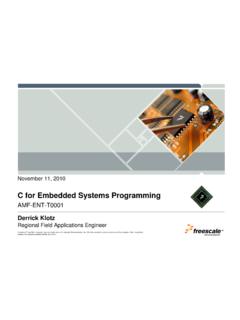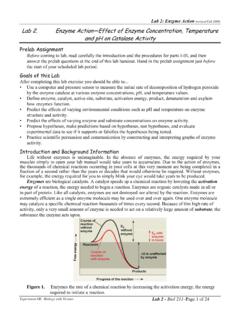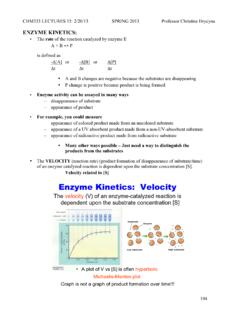Transcription of Lecture 3: Enzyme kinetics - School of Informatics ...
1 Computational systems biology1 Lecture 3: Enzyme kineticsFri 19 Jan 2009 Computational Systems BiologyImages from: D. L. Nelson, Lehninger Principles of Biochemistry, IV Edition, W. H. Freeman ed. A. Cornish-Bowden Fundamentals of Enzyme kinetics , Portland Press, 2004A. Cornish-Bowden Enzyme kinetics , IRL Press, 1988computational systems biology2 Summary: Simple Enzyme kinetics Steady-state rate equations Reactions of two substrates Inhibition of Enzyme activity pH dependence Biological regulation of enzymescomputational systems biology3 Simple Enzyme Kineticscomputational systems biology4 Basics Enzyme kinetics studies the reaction rates of Enzyme -catalyzedreactions and how the rates are affected by changes in experimental conditions An essential feature of Enzyme -catalyzed reactions is saturation.
2 At increasing concentrations of substrates the rate increases and approaches a limit where there is no dependence of rate on concentration (see slide with limiting rate Vmax) Leonor Michaelis and Maud Menten were among the first scientist to experiment with Enzyme kinetics in a modern way, controlling the pH of the solution etc. The convention used for this slides is to use UPPERCASEfor the molecular entity: E is an Enzyme molecule and italics lowercasefor the concentration: e0is the Enzyme concentration at time zero (initial concentration). Also square brackets can be used for concentration, [E] = Enzyme additional material: Fundamentals of Enzyme kinetics , Athel Cornish-Bowden, 2004 orEnzyme kinetics , Athel Cornish-Bowden and C.
3 W. Wharton, IRL Press, 1988computational systems biology5A simple view: E+A = EA as an equilibrium The mechanism: the first step of the reaction is the binding of the substrate (A) to the Enzyme (E) to form and Enzyme -substrate complex (EA) which then reacts to give the product P and free Enzyme E The concentrations: the total initial Enzyme concentration is e0 , and the complex concentration is x. The substrate (A) concentration should too be (a0-x), but since the substrate concentration is usually very high: The conversion is considered an equilibrium with equilibrium constant Ks The slowest step of the reaction is the EA to E+P and hence the dominant rate for all the reaction is the rate v = k0x or, considering the form 3.
4 P x x) a (e 00s P E kEA KA E 1. )(00xaaa )(K )([EA][E][A]K )(Kk computational systems biology6 Steady-state rate equationscomputational systems biology7 The steady-state assumption When the Enzyme is first mixed with a large excess of substrate there is an initial period, lasting just a few microseconds, thepre-steady state, during which the EA complex concentration builds up The reaction quickly achieves a steady state in which [ES] remains approximately constant over time (Briggs and Haldane, 1925)For additional material: Fundamentals of Enzyme kinetics , Athel Cornish-Bowden, 2004 orEnzyme kinetics , Athel Cornish-Bowden and C.
5 W. Wharton, IRL Press, 1988computational systems biology8A more general view: E+A EA as reversible The mechanism: the first step is now reversible with a forward (k1) and a backward (k -1) constant The rate of change of the concentration of intermediate (dx/dt) is the difference between the rate at which it is produced from E + A and the sum of the rates at which it is converted back into free E and A and forward into free E and P Briggs and Haldane postulated that dx/dt should be positive at the instant of mixing of E with A (because at the beginning there is no EA and then it builds up)but then the removal rate of EA would rapidly increase, until it balances the rate of production.
6 This is the steady-state p x x) a (e P E kEA kkA E 5. 0011- xkxkaxekx2101 - - )(dtd 6. 0 - - )(dtd xkxkaxekxcomputational systems biology9 The Michaelis-Menten equation: effects of substrate concentration on a reaction initialvelocity Rearranging equation 7. we obtain: the Michaelis-Menten equation, where Km (the Michaelis constant) is visible in the diagram as the concentration of substrate at which the initial velocity is half of the maximum velocity You can experiment with this equation on: on Chapter 6: enzymes Living graphs menuImages from: David L.
7 Nelson, Lehninger Principles of Biochemistry, IV Edition, W. H. Freeman m00K 0 1m Kkkk computational systems biology10 When ais much smaller than Kmit can be ignored giving:with first-order dependences on both Enzyme and substrate, or second-order kinetics overall. k0/Kmis thus called the second order rate constantor, more importantly, the specificity constant, as it is specific for each Enzyme type. As aincreases and surpasses Kmmaking it insignificant, 8. becomes: Where V is the limiting rate(better definition than Vmax , since the value is approached rather slowly, and never really reached) You can experiment with this equation on: on Chapter 6: enzymes Living graphs menuThe Michaelis-Menten equation: effects of substrate concentration on a reaction maximumvelocityImages from: David L.
8 Nelson, Lehninger Principles of Biochemistry, IV Edition, W. H. Freeman )K( v9. V ekcomputational systems biology11 Lineweaver-Burk equation The Lineweaver-Burk equation is a rewriting of the Michaelis-Menten equation that is often used for the (not very accurate)determination of kinetic parameters from the plot. It is useful for analysis of multi-substrate and inhibited enzymatic reactions (see next slides) You can experiment with this equation on: on Chapter 6: enzymes Living graphs menuaKmVV1v1 11. Double reciprocal plot:Images from: David L. Nelson, Lehninger Principles of Biochemistry, IV Edition, W.
9 H. Freeman systems biology12 Experimental investigation of fast reactions Thought natural chemical reactions were fast?( interconversion of bicarbonate and dissolved carbon dioxide) Think like carbonic anhydrase in your lungs can accelerate the reaction of a 107factor, processing a staggering 400000 molecules of HCO3-per second. The Enzyme converts the molecules almost as fast as they can diffuse in acqueous solution. Biochemists call it reaching catalytic perfection .How can we study such a fast process? Flow methods:involves a continuous flow of Enzyme and substrate through a mixing chamber in a long tube.
10 Observation at a certain distance gives a population of molecule of a fixed age from the instant of mixing. This allows reactions with a half-time of milliseconds to be studied with equipments requiring several seconds for each measurement. Stopped flow methods:similar, but with a mechanical syringe stopping the flow almost instantaneously. Or involving the addition of a quenching (stopping) agent ( trichloroacetic acid that destroys the Enzyme ) or bringing the mixture to a very low temperature with liquid nitrogen, so as to freeze the situation at a given instant. Perturbation methods:for extremely quick reactions the mixture already at steady state is given a temperature-jump of +10 C with an electric current.
















